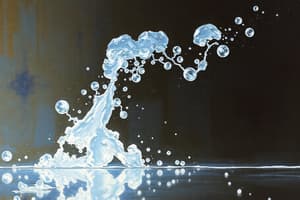Podcast
Questions and Answers
How does the addition of a common ion affect the equilibrium of a weak acid in solution, according to Le Chatelier's Principle?
How does the addition of a common ion affect the equilibrium of a weak acid in solution, according to Le Chatelier's Principle?
- Has no effect on the equilibrium as the common ion only affects strong acids.
- Shifts the equilibrium towards the side with fewer ions to balance the charge. (correct)
- Shifts the equilibrium towards the products, increasing the ionization of the weak acid.
- Shifts the equilibrium towards the reactants, decreasing the ionization of the weak acid.
A buffer solution contains a weak acid, HA, and its conjugate base, A⁻. Which of the following describes how this buffer resists changes in pH upon addition of a strong acid?
A buffer solution contains a weak acid, HA, and its conjugate base, A⁻. Which of the following describes how this buffer resists changes in pH upon addition of a strong acid?
- The weak acid, HA, neutralizes the added acid, preventing a decrease in pH.
- The water in the solution dilutes the added acid, minimizing the pH change. (correct)
- The conjugate base, A⁻, neutralizes the added acid, preventing a decrease in pH.
- The buffer reacts with water to produce more hydroxide ions, neutralizing the added acid.
Why does a mixture of HF (weak acid) and NaF (salt of its conjugate base) function as a buffer solution?
Why does a mixture of HF (weak acid) and NaF (salt of its conjugate base) function as a buffer solution?
- HF neutralizes added acids, while NaF neutralizes added bases.
- HF neutralizes added bases, while F⁻ from NaF neutralizes added acids. (correct)
- HF and NaF react with each other to maintain a neutral pH.
- NaF increases the concentration of H⁺ ions, which counteract pH changes.
Ammonia (NH₃) can react with HCl to form ammonium (NH₄⁺). How does this mixture act as a buffer?
Ammonia (NH₃) can react with HCl to form ammonium (NH₄⁺). How does this mixture act as a buffer?
What is the primary utility of the Henderson-Hasselbalch equation in acid-base chemistry?
What is the primary utility of the Henderson-Hasselbalch equation in acid-base chemistry?
During a titration, what is the key characteristic that defines the equivalence point?
During a titration, what is the key characteristic that defines the equivalence point?
In a titration, what distinguishes the 'end point' from the 'equivalence point'?
In a titration, what distinguishes the 'end point' from the 'equivalence point'?
What is the role of an indicator in a titration experiment?
What is the role of an indicator in a titration experiment?
During the titration of a weak acid with a strong base, when would you typically use an ICE table with molarities to calculate pH?
During the titration of a weak acid with a strong base, when would you typically use an ICE table with molarities to calculate pH?
In the context of titrations, under what circumstances is it most appropriate to use a reaction table with units in moles rather than molarity?
In the context of titrations, under what circumstances is it most appropriate to use a reaction table with units in moles rather than molarity?
What information does the solubility product constant, Ksp, provide about a compound?
What information does the solubility product constant, Ksp, provide about a compound?
What is molar solubility?
What is molar solubility?
How can you determine the Ksp of a salt if you know its molar solubility?
How can you determine the Ksp of a salt if you know its molar solubility?
According to the principles of solubility equilibria, how does the presence of a common ion affect the solubility of a sparingly soluble salt?
According to the principles of solubility equilibria, how does the presence of a common ion affect the solubility of a sparingly soluble salt?
Besides the common ion effect, what other factor can influence the solubility of salts?
Besides the common ion effect, what other factor can influence the solubility of salts?
How does the pH of a solution affect the solubility of salts containing basic anions (e.g., salts of weak acids)?
How does the pH of a solution affect the solubility of salts containing basic anions (e.g., salts of weak acids)?
Under what condition will precipitation occur when mixing two solutions containing ions that can form a sparingly soluble salt?
Under what condition will precipitation occur when mixing two solutions containing ions that can form a sparingly soluble salt?
What principle underlies the common ion effect?
What principle underlies the common ion effect?
Which scenario exemplifies the common ion effect?
Which scenario exemplifies the common ion effect?
Why is it essential to select an appropriate indicator for an acid-base titration?
Why is it essential to select an appropriate indicator for an acid-base titration?
During a titration, at what point is the pH equal to the pKa in a weak acid-strong base titration?
During a titration, at what point is the pH equal to the pKa in a weak acid-strong base titration?
When titrating a polyprotic acid (an acid with more than one ionizable proton) with a strong base, how many equivalence points would you expect to observe?
When titrating a polyprotic acid (an acid with more than one ionizable proton) with a strong base, how many equivalence points would you expect to observe?
What is the experimental purpose of performing a titration?
What is the experimental purpose of performing a titration?
In what way can temperature affect the solubility of a salt?
In what way can temperature affect the solubility of a salt?
What is the relationship between Q (the reaction quotient) and Ksp (the solubility product constant) at equilibrium for a saturated solution?
What is the relationship between Q (the reaction quotient) and Ksp (the solubility product constant) at equilibrium for a saturated solution?
In what way can pH affect the solubility of salts containing basic anions?
In what way can pH affect the solubility of salts containing basic anions?
How does the common ion effect impact the dissociation of a weak acid?
How does the common ion effect impact the dissociation of a weak acid?
Which of the following is a characteristic of a buffer solution?
Which of the following is a characteristic of a buffer solution?
What components are required to make a buffer solution?
What components are required to make a buffer solution?
When does precipitation occur?
When does precipitation occur?
What is titrant?
What is titrant?
Why do you need to use an ICE table only with molarities to determine pH during a weak-acid strong-base titration?
Why do you need to use an ICE table only with molarities to determine pH during a weak-acid strong-base titration?
In what manner does pH affect the solubility of salts containing basic anions (e.g., salts of weak acids)?
In what manner does pH affect the solubility of salts containing basic anions (e.g., salts of weak acids)?
If the molar solubility of $AgCl$ is $1.34 * 10^{-5}$ in pure water, what is the $K_{sp}$ of silver chloride?
If the molar solubility of $AgCl$ is $1.34 * 10^{-5}$ in pure water, what is the $K_{sp}$ of silver chloride?
Determine the molar solubility in pure water of $MgF_2 (Ksp = 6.4 * 10^{-9})$.
Determine the molar solubility in pure water of $MgF_2 (Ksp = 6.4 * 10^{-9})$.
Calculate the pH of a buffer solution that is 0.20 M in lactic acid ($CH_3CH(OH)COOH$) and 0.10 M in sodium lactate ($CH_3CH(OH)COOONa$). The $K_a$ for lactic acid is $1.4 × 10^{-4}$.
Calculate the pH of a buffer solution that is 0.20 M in lactic acid ($CH_3CH(OH)COOH$) and 0.10 M in sodium lactate ($CH_3CH(OH)COOONa$). The $K_a$ for lactic acid is $1.4 × 10^{-4}$.
Find the pH at the equivalence point in the titration of 50.0 mL of 0.20 M $CH_3COOH$ with 0.20 M NaOH. ($K_a$ = $1.8 * 10^{-5}$)
Find the pH at the equivalence point in the titration of 50.0 mL of 0.20 M $CH_3COOH$ with 0.20 M NaOH. ($K_a$ = $1.8 * 10^{-5}$)
Which of the following is least likely to increase the solubility of an ionic compound in water?
Which of the following is least likely to increase the solubility of an ionic compound in water?
What are the indicators made up of?
What are the indicators made up of?
Is it possible for the pH to fall within the acidic range at the equivalence point of a titration?
Is it possible for the pH to fall within the acidic range at the equivalence point of a titration?
Flashcards
Common Ion Effect
Common Ion Effect
The common ion effect is when a solution contains two substances sharing a common ion, reducing solubility or ionization.
Buffer Solution
Buffer Solution
A solution that resists changes in pH upon addition of small amounts of acids or bases, containing a weak acid/base and its conjugate.
HF and NaF as buffer
HF and NaF as buffer
HF is a weak acid that can neutralize added bases, and NaF provides the conjugate base (F-) to neutralize added acids.
NH3 and HCl as Buffer
NH3 and HCl as Buffer
Signup and view all the flashcards
Henderson-Hasselbalch Equation Uses
Henderson-Hasselbalch Equation Uses
Signup and view all the flashcards
Titration
Titration
Signup and view all the flashcards
Titrant
Titrant
Signup and view all the flashcards
Equivalence Point
Equivalence Point
Signup and view all the flashcards
End Point
End Point
Signup and view all the flashcards
Indicator
Indicator
Signup and view all the flashcards
Solubility Product Constant (Ksp)
Solubility Product Constant (Ksp)
Signup and view all the flashcards
Molar Solubility
Molar Solubility
Signup and view all the flashcards
Effect of Common Ion on Solubility
Effect of Common Ion on Solubility
Signup and view all the flashcards
Factors Affecting Solubility
Factors Affecting Solubility
Signup and view all the flashcards
Precipitation Conditions
Precipitation Conditions
Signup and view all the flashcards
Study Notes
Common Ion Effect and Le Chatelier's Principle
- The common ion effect occurs when a solution contains two substances sharing a common ion
- Presence of a common ion reduces the solubility or ionization of one of the substances
- Le Chatelier's Principle explains this: adding more of a product (like a common ion) shifts the reaction to use up that product, favoring the reactants
- In a solution of HF (HF + H2O = H3O+ + F-), adding NaF introduces F-, causing the reaction to shift left
Buffer Solutions
- Buffer solutions resist changes in pH upon addition of small amounts of acids or bases
- Buffers contain both an acid and its conjugate base or a base and its conjugate acid
- When acid is added, the base component of the buffer reacts with it
- When base is added, the acid component reacts with it, maintaining a stable pH
HF/NaF Buffer
- HF is a weak acid
- NaF provides its conjugate base, F-
- HF neutralizes added bases
- F- neutralizes added acids
- This combination stabilizes the solution's pH
NH3/HCl Buffer
- NH3 (ammonia) is a weak base
- HCl reacts with NH3 to form NH4+, which is the conjugate acid
- NH3 reacts with added acids
- NH4+ reacts with added bases, resisting pH changes
Henderson-Hasselbalch Equation
- It calculates the pH of a buffer
- An alternative method involves determining moles of conjugate acid/base after adding strong acid/base, calculating concentrations, using an ICE table, and solving for pH
- The equation offers a faster approach compared to the ICE table method
Titration Terminology
- Titration: An experimental method where one solution is gradually added to another until the reaction is complete, often to determine the concentration of a substance
- Titrant: The solution added from a burette during titration
- Equivalence Point: The point where the amount of acid equals the amount of base
- End Point: The point where the indicator changes color, indicating the titration is complete
- Indicator: A substance that changes color at a certain pH to signal the end of a titration
Titration Curves
- Strong acid, strong base titration: Refer to figure 17.3
- Weak acid, strong base titration: Refer to figure 17.4
- Strong acid, weak base titration: Refer to figure 17.6
Reaction Tables for Titration
- Use an ICE table with molarities for weak acid or weak base solutions because they are equilibrium systems
- This is applicable at the beginning of the titration, before adding any titrant, and at the equivalence point
- Use a reaction table in units of moles at every other point in the titration where there is a mixture of a weak acid/base and a strong base/acid present. This is because you have a reaction that goes to completion
Solubility Product Constant (Ksp)
- Ksp indicates how soluble a compound is in water
- It is the product of the concentrations of ions in a saturated solution, raised to the power of their coefficients in the balanced equation
Molar Solubility
- Molar solubility is the number of moles of a compound that can dissolve in 1 liter of water before the solution becomes saturated
Ksp and Molar Solubility Relationship
- One can be calculated from the other using an ICE table
- Given molar solubility ('x'), one can calculate Ksp
- Given Ksp, one can solve for 'x' to find molar solubility
Common Ion Effect on Salt Solubility
- The common ion effect decreases the solubility of a salt
- If one of the salt's ions is already in the solution, introduction of more of the same ion decreases the salt's solubility, shifting the equilibrium towards the undissolved salt
Factors Affecting Salt Solubility (Excluding Common Ion Effect)
- Temperature: Higher temperatures usually increase solubility
- pH: Changes in pH can increase or decrease solubility, especially for salts with acidic or basic ions
- If an ion in the salt is a conjugate of a weak acid or base, pH affects the amount of that ion in solution.
- For example, AgCN contains CN-, which is the conjugate base of HCN; increasing pH increases OH-shifts the equilibrium towards reactants, increasing CN- in solution and decreasing AgCN solubility
Precipitation Conditions
- Precipitation occurs when the product of ion concentrations in a solution exceeds Ksp
- Reaction quotient (Q) helps determine if precipitation will occur
- If Q > Ksp, a precipitate will form
Studying That Suits You
Use AI to generate personalized quizzes and flashcards to suit your learning preferences.




